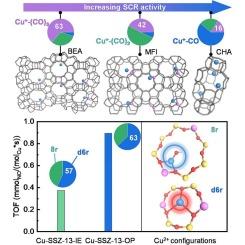DB-FTIR光谱揭示了低温NH3-SCR催化NOx的沸石催化剂中Cu物种的禁闭驱动调制
IF 6.5
1区 化学
Q2 CHEMISTRY, PHYSICAL
引用次数: 0
摘要
沸石框架内活性位点的限制对Cu基催化剂的低温氨选择性催化还原(NH3-SCR) NOx的性能起着至关重要的作用,但有关活性Cu物种性质的机理尚不清楚。在这里,我们通过整合先进的表征,包括x射线吸收光谱,原位双束傅立叶变换红外光谱,低温CO/NO吸附,以及Cu- ssz -13, Cu- zsm -5, Cu- beta和氧化物负载类似物的催化评价,系统地阐明了Cu物种的拓扑驱动调制。结果表明:1)与MFI和BEA拓扑结构相比,CHA框架内的强空间约束优先为羰基物种形成最丰富的低配位Cu+位点,并稳定了六元环中的Z2Cu2+物种,增强了Cu+/Cu2+的氧化还原循环,从而提高了NO吸附和硝酸盐转换效率。ii)离子交换和一锅合成方法强烈影响Cu-SSZ-13中Cu2+的分布和位置,进而影响活性。原位光谱的机理揭示了拓扑控制的Cu形态决定了关键硝酸盐中间体的形成和消耗,从而实现了高效的低温SCR循环。这些发现不仅为含cu沸石催化剂建立了清晰的拓扑-活性关系,而且为催化剂的合理设计提供了机理蓝图,推动了NOx减排技术的发展,以满足日益严格的排放法规。本文章由计算机程序翻译,如有差异,请以英文原文为准。

DB-FTIR spectroscopy unravels confinement-driven modulation of Cu species in zeolite catalysts for low-temperature NH3-SCR of NOx
The confinement of active sites within zeolite frameworks critically governs the performance of Cu-based catalysts for low-temperature ammonia selective catalytic reduction (NH3-SCR) of NOx, but the mechanistic insights regarding the nature of active Cu species remain elusive. Here, we systematically elucidate the topology-driven modulation of Cu species by integrating advanced characterizations, including X-ray absorption spectroscopy, in situ dual-beam Fourier transform infrared spectroscopy, low-temperature CO/NO adsorption, and catalytic evaluations across Cu-SSZ-13, Cu-ZSM-5, Cu-Beta, and oxide-supported analogues. We demonstrate that, i) in comparison to MFI and BEA topologies, the strong spatial confinement within the CHA framework preferentially forms most abundant Cu+ sites with low-coordination numbers to carbonyl species, and stabilizes Z2Cu2+ species in six-membered rings, enhancing Cu+/Cu2+ redox cycle and thus NO adsorption and nitrate turnover efficiency. ii) The ion-exchange and one-pot synthesis methods strongly influence the distribution and location Cu2+ species in Cu-SSZ-13 that further influence the activity. Mechanistic insights from in situ spectroscopy reveal that topology-governed Cu speciation dictates the formation and consumption of critical nitrate intermediates, enabling efficient low-temperature SCR cycles. These findings not only establish a clear topology-activity relationship for Cu-containing zeolite catalysts but also offer a mechanistic blueprint for the rational design of catalysts, advancing NOx abatement technologies to meet increasingly stringent emission regulations.
求助全文
通过发布文献求助,成功后即可免费获取论文全文。
去求助
来源期刊

Journal of Catalysis
工程技术-工程:化工
CiteScore
12.30
自引率
5.50%
发文量
447
审稿时长
31 days
期刊介绍:
The Journal of Catalysis publishes scholarly articles on both heterogeneous and homogeneous catalysis, covering a wide range of chemical transformations. These include various types of catalysis, such as those mediated by photons, plasmons, and electrons. The focus of the studies is to understand the relationship between catalytic function and the underlying chemical properties of surfaces and metal complexes.
The articles in the journal offer innovative concepts and explore the synthesis and kinetics of inorganic solids and homogeneous complexes. Furthermore, they discuss spectroscopic techniques for characterizing catalysts, investigate the interaction of probes and reacting species with catalysts, and employ theoretical methods.
The research presented in the journal should have direct relevance to the field of catalytic processes, addressing either fundamental aspects or applications of catalysis.
 求助内容:
求助内容: 应助结果提醒方式:
应助结果提醒方式:


